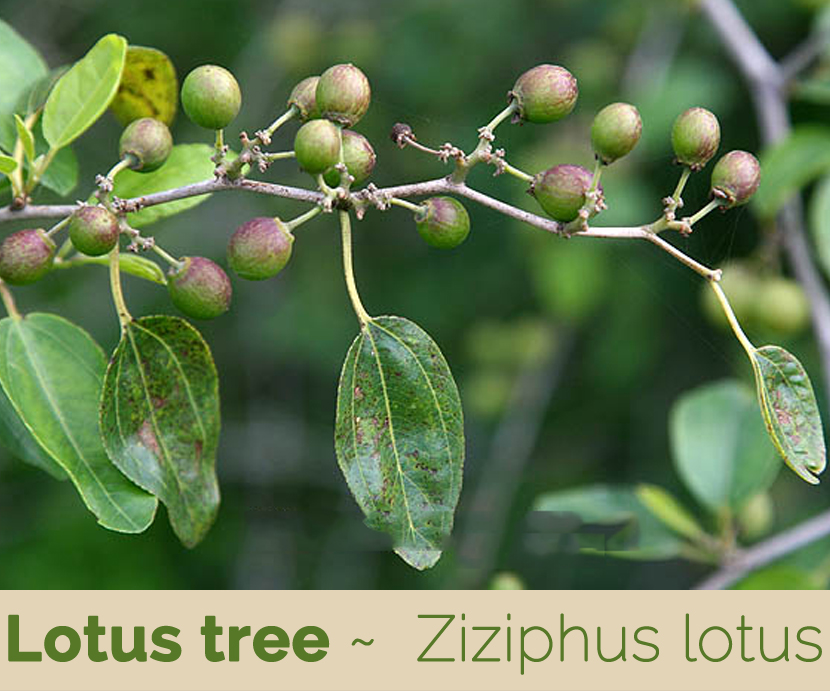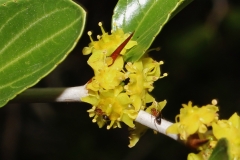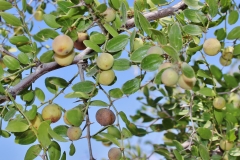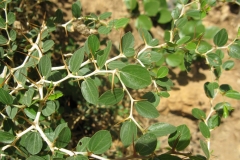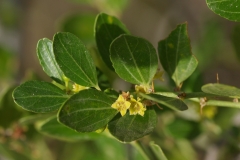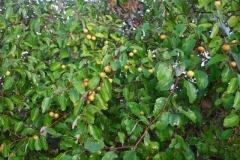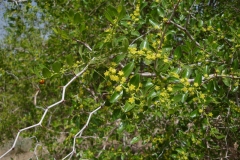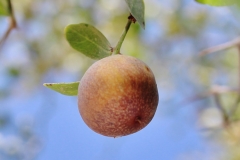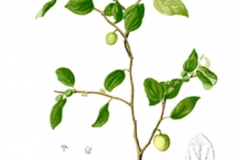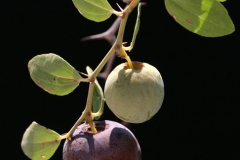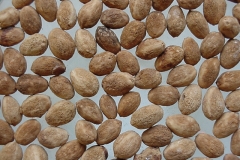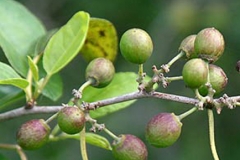| Lotus tree Quick Facts |
| Name: |
Lotus tree |
| Scientific Name: |
Ziziphus lotus |
| Origin |
Mediterranean region, like Algeria, Morocco, Tunisia, and Libya except France and Italy |
| Colors |
Brown-reddish |
| Shapes |
Sub globose and brown-reddish drupe, 1–2 cm in diameter, |
| Taste |
Sweet and sugary |
| Calories |
61 Kcal./cup |
| Major nutrients |
Vitamin C (96.00%)
Magnesium (88.81%)
Manganese (82.61%)
Calcium (49.00%)
Vitamin E (36.07%)
|
| Health benefits |
Beneficial for anti-urinary troubles, anti-diabetes, skin infections, anti-fever, anti-diarrhea, insomnia, bronchitis, eye leucomas, respiratory and cardiac diseases |
Lotus tree scientifically known as Ziziphus lotus is a deciduous shrub in the buckthorn family Rhamnaceae. The plant is native to the Mediterranean region, like Algeria, Morocco, Tunisia, and Libya except France and Italy. It is one of several species called “jujube”, and is closely related to Z. jujuba, the true jujube. Few of the popular common names of the plant are African jujube, Lote fruit, Lotus tree, Lotus, Lotus jujube and wild jujube. The plant is used in nutrition, health, and cosmetics in several forms, for example, honey, tea, jam, juice, oil, loaf, and cake.
Plant Description
Lotus tree is an intricately branched, dense deciduous thorny shrub that grows about 2–5 meters (6.6–16.4 ft.) tall. The plant is found growing in arid and semiarid regions throughout the world. The plant prefers deep clayey soils for better growth of the plant. The plant has grey, zigzagged, and frequently curved, down branches. Alternate leaves are 2–4 cm long, elliptical, shallowly crenate, with three parallel longitudinal veins in their surface. There are two hard thorns in the insertions of each leaf; one is straight and the other is hooked.
Flower & Fruit
Flowers are small, arranged in racemes. They are actinomorphic, bisexual, and green-yellowish. They are not conspicuous from afar, but secrete large amounts of nectar and are visited by numerous insects, mainly honeybees. The flower has 5 sepals, 5 petals, 5 stamens. Flowering normally takes place between March and April. Fertile flowers are followed by a sub globose and brown-reddish drupe, 1–2 cm in diameter, with a large stone in the center and surrounded by a dry fleshy pulp. It fruits ripen in autumn.
Cultural and religious references
Ziziphus lotus is often considered as the lotus tree of Greek mythology. It is supposed to be referenced in the Odyssey, consumed by the Lotus-Eaters as a narcotic to induce peaceful apathy.
A sacred lotus tree planted near the temple of Vulcan in Rome was said to have been planted by Romulus, who is said to have been a contemporary of the composer[s] of the Odyssey (8th century BCE); it was still standing some 700 years later, in the time of Pliny the Elder.
In Arabic-speaking regions the Ziziphus lotus and alternatively the jujube are closely associated with the lote-trees (sidr) which are mentioned in the Quran, while in Palestine it is rather the Ziziphus spina-christi that is called sidr. Elsewhere in the Arab world the European and Chinese jujubes are also associated with the Lote-trees (sidr).
The nineteenth century English explorer, Richard Francis Burton reported seeing an ancient sidr tree in the mosque containing the Prophet Muhammad’s tomb in Medina. It was in a garden dedicated to the prophet’s daughter, Fatimah. The fruit from the tree was being sold to pilgrims and its leaves used for washing dead bodies.
History
Ziziphus fruit remains, which could be assigned to Z. lotus and Z. spina-christi, have been found in a number of archaeological excavations, in west Asia and Egypt, dated from Neolithic and Bronze Age (Azam-Ali et al. 2006). Its profusion in Libya was mentioned by Herodotus (fifth century BC) and Theophrastus (third century BC), describing its edible fruits, with a sweetness similar to dates, and identifying them with those consumed by the mythological lotus-eaters (lotophages) referred to in the Homer’s Odyssey. They also mentioned that the fruits were used to make wine. The same was repeated by Pliny the Elder in the first century AD, also adding that those who eat its fruits are subject to no maladies of the stomach.
Traditional uses and benefits of Lotus tree
- In traditional medicine, Z. lotus is used as anti-diabetes, sedative, bronchitis, and anti-diarrhea by local populations.
- Several parts of Z. lotus are given as anti-urinary troubles agents, anti-diabetes, skin infections, anti-fever, anti-diarrhea, insomnia agents, sedative, bronchitis, and hypoglycemic activities.
- Powder of dried leaves and fruit mixed with water or milk is used for the treatment of boils.
- Root bark is used for the treatment of diabetes.
- Juice from Z. lotus root would be efficient in the treatment of eye leucomas.
- Fruits and the leaves of Z. lotus are used as emollient and in the treatment of diarrhea and intestinal diseases.
- Different parts of the plant (fruits, leaves, and root) have been used in North African traditional medicine for treating diverse ailments, such as diabetes, digestive, respiratory and cardiac diseases, or skin problems.
- Leaf powder is applied topically for treating abscesses and wounds.
- Fruit decoction is used for treating diabetes, digestive and respiratory problems in central Morocco.
Culinary Uses
- lotus fruits would still be consumed by local population in North Africa.
- Fruits are dried and processed into flour to make pancakes with very pleasant flavor.
- Edible fruits, though not of high quality, have been consumed in some countries of the Mediterranean region, such as southeast Spain, Cyprus, Turkey, Jordan and Morocco.
- They are mainly eaten as a dessert, both raw when ripe or after dehydration throughout the year, though they are also used to prepare jams or even an acid beverage in Lybia.
- In the north of Africa, the dried fruits are ground into flour for making bread and the seeds kernel to make amlou, a Moroccan chunky paste usually made with argan oil, almonds or peanuts, and sometimes honey or sugar.
- Fruits are prized by nomads that take them as travel provisions and frequently sold in local markets and on roadsides, at least in some Moroccan localities.
- Fruits of other wild species of the same genus are also consumed and frequently considered of better quality.
- They are also used for making preserves, or can be dried and then made into flour for making bread etc.
Other facts
- This plant has been also used as fodder and honey plant, fuel, and for hedges and erosion control.
- The plant is occasionally grown as a hedge, where its prickly stems can act as a barrier.
- Flowers are attractive to bees.
- Prickly branches are used to make stock-proof barriers.
- The wood is used for fuel.
References:
https://www.itis.gov/servlet/SingleRpt/SingleRpt?search_topic=TSN&search_value=506081#null
https://davesgarden.com/guides/pf/go/190816/
https://plants.usda.gov/core/profile?symbol=ZILO
http://www.theplantlist.org/tpl/record/kew-2470687
https://en.wikipedia.org/wiki/Ziziphus_lotus
https://www.cabi.org/isc/datasheet/57555
https://wikivisually.com/wiki/Ziziphus_lotus
Comments
comments


